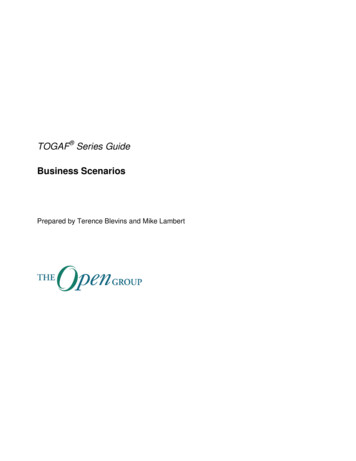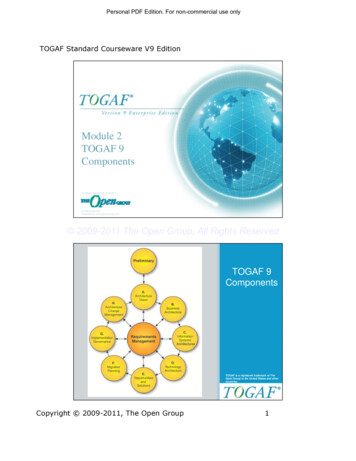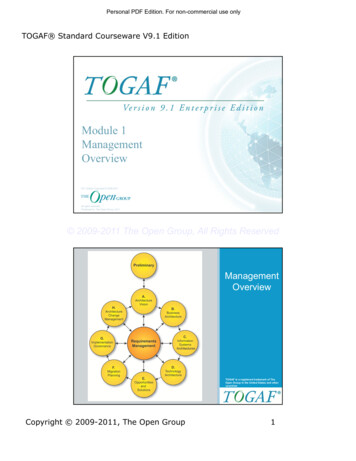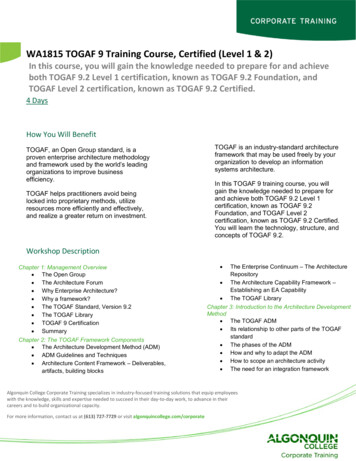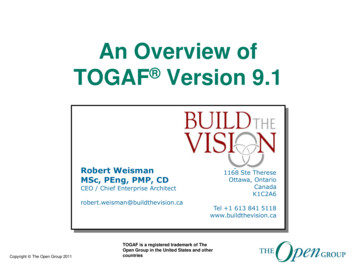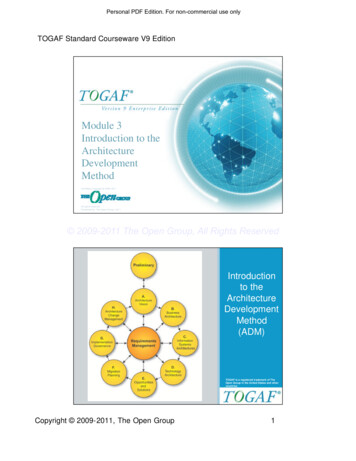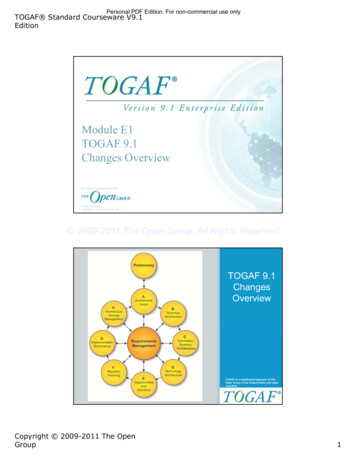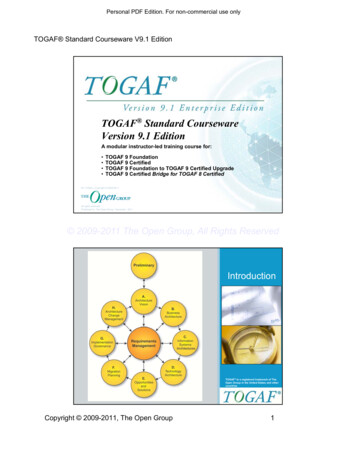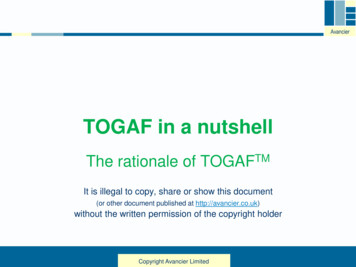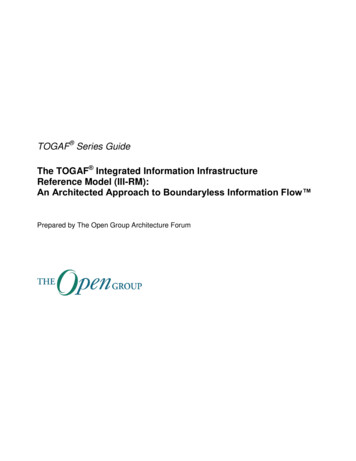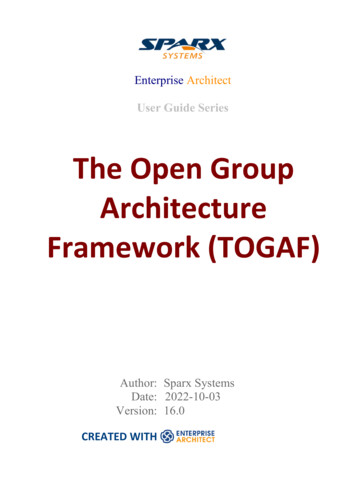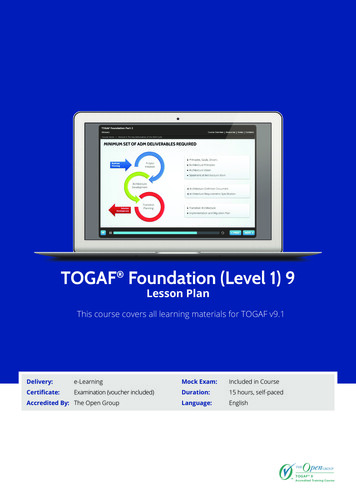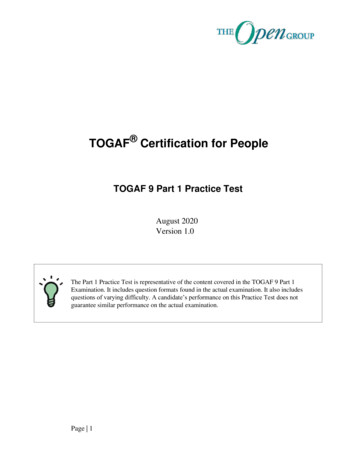
Transcription
TOGAF Certification for PeopleTOGAF 9 Part 1 Practice TestAugust 2020Version 1.0The Part 1 Practice Test is representative of the content covered in the TOGAF 9 Part 1Examination. It includes question formats found in the actual examination. It also includesquestions of varying difficulty. A candidate’s performance on this Practice Test does notguarantee similar performance on the actual examination.Page 1
Copyright Web Age SolutionsAll rights reserved.No part of this publication may be reproduced, stored in a retrieval system, or transmitted, in any form or by anymeans, electronic, mechanical, photocopying, recording, or otherwise, without the prior permission of the copyrightowner.Boundaryless Information Flow is a trademark and Making Standards Work , The Open Group , TOGAF ,UNIX , and the “X” device are registered trademarks of The Open Group in the United States and other countries.Page 2
CONTENTS12Instructions. 4Examination . 4Page 3
1 INSTRUCTIONSThis is a simple multiple choice test. This test should be taken as a closed book test. There is one correctanswer for each question, scoring 1 point. You need to score 24 or more points1 out of a maximum of 40to pass this test.Please read each question carefully before reading the answer options. Be aware that some questions mayseem to have more than one right answer, but you are to look for the one that makes the most sense and isthe most correct.2 EXAMINATIONItem 1Question: Which of the following entities could possibly form an Enterprise according to TOGAF?A.B.C.D.E.The customers of a local bakery.A third-party supplier of fabric supplies to a clothing retail business.The Human Resources department of an insurance company.Only B and C above.A, B and C above.Item 2Question: Which of the following is a possible definition in TOGAF, according to context, of architecture?A.B.C.D.E.An informal description of a system and its components, used to guide further architectural planning,A detailed plan of a system at a component level that guides its development.A plan for how to operationalize an ICT system that captures its components and their interactions.The formal technical design of an ICT system.A business process model showing tasks, activities, actors and resources.Item 3Question: TOGAF defines the development of four key architecture domains. Which of the following is NOT one echnology1Note that this pass mark may differ from the live TOGAF 9 Part 1 Examination. Consult The Open Groupcertification web site for the latest information on examination pass marks.Page 4
Item 4Question: Which is NOT one of the six parts of the TOGAF 9.2 standard?A.B.C.D.E.Architecture Development LifecycleIntroductionArchitecture Content FrameworkArchitecture Capability FrameworkEnterprise Continuum and ToolsItem 5Question: Which Phase of the ADM includes identifying key stakeholders who will be involved in yourarchitecture transformation effort?A.B.C.D.E.Phase APhase BPhase CPhase DPhase EItem 6Question: What is an architectural work product referred to that comes in one of three types: Catalogue, Matrixor Diagram?A.B.C.D.E.A DeliverableA Building BlockAn ArtifactA Work ItemAn Architectural OutputItem 7Question: The ADM supports the concept of iteration in which of the following ways?A. You can move from one phase to the next following the arrows and completing a full cycle of the ADM as manytimes as is needed to fully develop your architecture, but you can never go back to a previous phase.B. You can only iterate between the Business, Application, Data and Technology architecture development phases;you must execute the other phases in sequence.C. Once a Phase has been completed you must continue around the ADM until you arrive back at that phase ifyou want to make additional architectural enhancements.D. You can iterate around the ADM and within a single phase as many times as you like, as well as jumping backto a previously completed phase over and over again.E. You can repeat activities within any phase over and over again and then proceed to the next phase.Page 5
Item 8Question: In which Phases of the ADM are impacts across the architecture landscape resolved?A.B.C.D.E.Phases A, B and C.Phases P, A, B and C.Phases B, C and D.Phases B, C, D and E.Phases E and F.Item 9Question: When executing the ADM, when should you consider the re-use of architectural artifacts stored in theArchitecture Repository?A. In Phase A, when determining the architectural vision.B. When executing Requirements Management you need to consider which artifacts are available for the phasethat feeds into this.C. At relevant places throughout the ADM, there are reminders to consider which architecture assets from theArchitecture Repository you should use.D. In every phase, you need to consider re-using existing artifacts.E. You only need to consider these during Phases B, C and D since this is when you are defining new architectures.Item 10Question: Which of the following statements is NOT true with respect to the Enterprise Continuum?A. The Enterprise Continuum is a way of classifying contextual assets used to develop architectures such aspolicies and standards.B. The Enterprise continuum is actively used during the execution of the ADM.C. The Enterprise Continuum can be used to classify solutions (as opposed to descriptions or specifications ofsolutions).D. The Enterprise Continuum contains two specializations, namely the Architecture and Solutions continuums.E. The Enterprise Continuum evolve from Foundation Architectures to Organisation-specific Architectures.Item 11Question: Which of the following should be classified as a Foundational Solution within the Solutions Continuum?A.B.C.D.E.An enterprise management system productA foundational structure for organizing IT operations such as ITILA financial management tool such as Oracle Financials Cloud.The internal onboarding process for a state or provincial government.A Customer Relationship Management tool such as Salesforce.Page 6
Item 12Question: Which of the following statements most accurately describes the relationship between the EnterpriseContinuum and the Architecture Repository in TOGAF?A.B.C.D.E.They are not directly related.The Architecture Repository is a model for a logical instance of the Enterprise Continuum.The Architecture Repository is structured according to the Enterprise Continuum.The Architecture Repository is a model for a physical instance of the Enterprise Continuum.The Enterprise Continuum classifies the Architecture Metamodel within the Architecture Repository.Item 13Question: To manage the content of the Enterprise Continuum we need tools in order to:A.B.C.D.E.Ensure common terminology is usedProvide stakeholders with relevant modelsPromote asset re-useOnly A and C above.A, B and C above.Item 14Question: Which of the following responses does NOT complete the next sentence? The Preliminary Phaseincludes the activity of A.B.C.D.E.Establishing architecture principlesCustomizing TOGAF to co-exist with any other existing frameworks.Obtaining management commitmentScoping the architecture effort for an iteration of the ADM.Understanding the organisational context, such as culture and existing business processes.Item 15Question: A payment terminal in one of the over 300 stores nationally belonging to a women’s clothing retailerbreaks down and can no longer except credit card payments. According to TOGAF, this is a Simplification Change.In which Phase is this analysis performed?A.B.C.D.E.Phase EPhase FPhase GPhase HRequirements ManagementPage 7
Item 16Question: In which Phase of the ADM is the following architecture developed: Business processes, theirrelationships to each other and to people and the principles that govern future design?A.B.C.D.E.Phase APhase BPhase CPhase DPhase EItem 17Question: Which one of the concepts listed below is NOT a key concept in the transition from developing todelivering a target architecture?A.B.C.D.E.Developing an Architecture Roadmap.Grouping effort into Work Packages.Defining Transition Architectures.Developing an Implementation Governance plan.Creating an Implementation and Migration Plan.Item 18Question: In which phase of the ADM is the business value and cost of work packages and Transition Architecturescommunicated to key stakeholders?A.B.C.D.E.Phase EPhase FPhase GRequirements ManagementPreliminaryItem 19Question: Which activity below is NOT performed as part of, or in parallel with, Phase G of the ADM?A. Establishing a program within the organisation that will be responsible for delivering the target architecture.B. Overseeing the architecture implementation according to the organisation’s corporate and ICT governance.C. Govern the ICT personnel for the organisation to ensure effective delivery of target and transitionarchitectures.D. Defining an operations framework which will provide ongoing maintenance and evergreening of the finaldeployed solution.E. Make use of the organisation’s Portfolio or Program management capabilities to deliver the target architecture.Page 8
Item 20Question: In Phase D the architecture team must consider relevant technology architecture resources. Which ofthe resources listed below is NOT one of these?A.B.C.D.E.Generic technology models relevant to the organization's industry vertical sector.The TOGAF Technical Reference Model (TRM)Existing IT servicesTechnology models relevant to Common Systems Architectures; for example, the III-RM.Business process modelsItem 21Question: In which phase are gaps between the baseline and target architectures across all domains, consolidatedinto work packages?A.B.C.D.E.Phase EPhase FPhase GPhase HRequirements ManagementItem 22Question: What are the 5 criteria that can be used to distinguish a well-written principle from a poor one?A.B.C.D.E.Understandability, Stability, Completeness, Robustness, and ClarityUnderstandability, Availability, Completeness, Robustness, and ConsistencyUnderstandability, Stability, Completeness, Reusability, and ConsistencyUnderstandability, Stability, Completeness, Robustness, and ConsistencyComprehensibility, Stability, Completeness, Robustness, and ConsistencyItem 23Question: Which option below completes the sentence: A Business Scenario is A.B.C.D.E.a technique for eliciting technical requirements that a business must address. a technique for identifying and eliciting business requirements that an architecture must address. a way of modeling a business architecture that addresses the architectural requirements. a technique for expressing business workflows that an architecture must address. a way to capture business aspects that must be addressed by the target architecture.Item 24Question: Which of the following is NOT a potential source of gaps when using the Gap Analysis technique inTOGAF?A. PeopleB. FinancialsPage 9
C. Project ManagementD. Missing dataE. Eliminated applicationsItem 25Question: Which of the following statements with respect to how interoperability manifests within the ADM isNOT true.A. In Phase A the nature and security considerations of information and service exchanges are found usingbusiness scenarios.B. In Phase D appropriate technical mechanisms to permit information and service exchanges are specified.C. In Phase C the use of open data standards to represent the information exchange model ensures maximuminteroperability.D. In Phase B information and service exchanges are defined in business terms.E. In Phase F interoperability is planned for and implemented as a result of prior architectural considerations.Item 26Question: Which of the following best describes the Business Transformation Readiness Assessment technique?A. A technique to define the extent to which an organisation will share information and services betweendepartmentsB. A technique used to validate the degree to which an architecture is ready to be transformed.C. A technique used to identify and understand the business requirements an architecture must addressD. A technique used to develop general rules and guidelines for the architecture being developedE. A technique for assessing how rapidly an organisation is able to transform.F. A technique used to understand the readiness of an organization to accept change.Item 27Question: Complete the sentence: “Business transformation risks are first identified in Phase andmaintained as governance artifacts in Phase . “A.B.C.D.E.P and GA and GE and GG and HRequirements Management and GPage 10
Item 28Question: Capability-Based Planning is a business planning technique that focuses on A.B.C.D.E. return on investment achieving business goals maximizing business efficiency improving stakeholder returns achieving technical outcomesItem 29Question: Which of the following is NOT an objective of Architecture Governance?A. Implementing a system of controls over the creation and monitoring of all architectural components andactivities, to ensure the effective introduction, implementation, and evolution of architectures within theorganizationB. Implementing a system to ensure compliance with internal and external standards and regulatory obligationsC. Establishing processes that support effective management of the above processes within agreed parametersD. Developing practices that ensure accountability to a clearly identified stakeholder community, both inside andoutside the organizationE. Establishing an ICT capability for effective delivery of architecture projects through business-technologyalignmentItem 30Question: What are the 5 key concepts within the Architecture Governance FrameworkA.B.C.D.E.Process, Context, Content, Repository and Process Flow ControlProcess, Environment, Content, Registry and Process Flow ControlCompliance, Context, Content, Dispensary and Process Flow ControlProcess, Context, Content, Repository and WorkflowBusiness Control, Context, Policies, Repository and WorkflowItem 31Question: Which of the following is NOT a responsibility of the Architecture Board?A.B.C.D.E.Enforcement of Architecture ComplianceImproving the maturity level of architecture discipline within the organizationProviding the basis for all decision-making with regard to changes to the architecturesImproving and optimizing the business architecture through better integration of people and technologyEnsuring that the discipline of architecture-based development is adoptedPage 11
Item 32Question: What are the 6 levels of Architecture Conformance?A.B.C.D.E.Relevant, Consistent, Compliant, Fully-Compliant, Fully Conformant and Non-ConformantNon-consistent, Consistent, Compliant, Conformant, Fully Compliant and Non-ConsistentIrrelevant, Consistent, Compliant, Conformant, Fully Conformant and Non-ConformantInconsistent, Consistent, Compliant, Conformant, Fully Compliant and Non-CompliantUnrelated, Consistent, Compliant, Conformant, Fully Compliant and Non-ConformantItem 33Question: Which of the following statements is NOT correct?A. A stakeholder has one or more concerns about a system, and a concern can be shared by one or morestakeholders.B. A Viewpoint is relevant to one or more Stakeholders, and a Stakeholder makes use of one or more Viewpoints.C. A Viewpoint is a specification of the conventions for a set of different kinds of architectural descriptions.D. A view is specified by means of a viewpoint, which prescribes the concepts, models, analysis techniques, andvisualizations that are provided by the viewE. A viewpoint addresses a related set of concerns and a concern is addressed by one or more viewpoints.Item 34Question: A Viewpoint can be described using a set of related elements. What are they?A.B.C.D.E.Stakeholders, System, Model and View.Stakeholders, Concerns, Diagram and View.Stakeholders, Concerns, Model and Description.Stakeholders, Requirements, Modeling Technique and View.Stakeholders, Concerns, Model and View.Item 35Question: In which Phase of the ADM is a high-level model of candidate building blocks developed?A.B.C.D.E.Phase APhase BPhase CPhase DPhase EPage 12
Item 36Question: In which Phase of the ADM are building blocks aggregated into work packages in order to addressarchitectural gaps?A.B.C.D.E.Phase APhase BPhase CPhase DPhase EItem 37Question: Which description below best describes the nature of an Architecture Contract, according to TOGAF?A. Architecture Contracts are the joint agreements between development partners and sponsors on thedeliverables, quality, and fitness-for-purpose of an architecture.B. Architecture Contracts are legally binding agreements between Enterprise Architects and customers thatguarantee the final product meets all their requirements.C. Architecture Contracts are service-level agreements between architecture and the rest of the organisation thatensure the final architecture is fit-for-purpose.D. Architecture Contracts establish a binding agreement between the Architecture Board and the EnterpriseArchitecture team that governs their roles, responsibilities and performance metrics.E. Architecture Contracts provide a legal foundation for governance at the corporate level of the architecturecapability within the organisation.Item 38Question: Which of the following statements does NOT accurately describe how the Architecture DefinitionDocument is altered in each phase of the ADM?A.B.C.D.E.It is first created in Phase A, where it is populated with artifacts created to support the Architecture Vision.It is updated in Phase B, with Business Architecture-related material.It is subsequently updated with Database and Application Architecture content in Phase C.It is then updated with Technology Architecture content in Phase D.Where the scope of change to implement the Target Architecture requires an incremental approach, theArchitecture Definition Document will be updated to include one or more Transition Architectures in Phase EItem 39Question: The Technical Reference Model (TRM) has three main parts; what are they?A.B.C.D.Applications, Data storage platform and Communications Platform.Applications, Application Platform and Communications Infrastructure.Applications, Application Platform and Network InfrastructureSoftware Systems, Application Platform and Network InfrastructurePage 13
E. Software, Application Platform, Communications InfrastructureItem 40Question: The Application Platform within the III-RM contains five main components: Information ConsumerApplications, Information Provider Applications, and Brokering Applications are three of them. The other twoare:A.B.C.D.E.Development Tools and Monitoring UtilitiesDesign Tools and Management ToolsSecurity and Management ToolsPerformance SLAs and Development ToolsDevelopment Tools and Management UtilitiesPage 14
Page 15
C. The Enterprise Continuum can be used to classify solutions (as opposed to descriptions or specifications of solutions). D. The Enterprise Continuum contains two specializations, namely the Architecture and Solutions continuums. E. The Enterprise Continuum evolve from Foundation Architectures to Organisation-specific Architectures. Item 11
